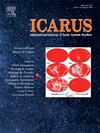火星中部塔尔西斯地区晚亚马逊连续火山喷发、同时期构造和坑链形成:对长期岩浆活动和地幔柱的影响
IF 3
2区 物理与天体物理
Q2 ASTRONOMY & ASTROPHYSICS
引用次数: 0
摘要
塔尔西斯隆起拥有火星上一些最大的盾状火山。其中,Arsia Mons、Pavonis Mons和ascreeus Mons是塔尔西斯中部地区较为突出的火山。这些火山及其相关的构造特征和坑链在晚亚马逊时期的时空演化对于理解塑造它们的地球动力学过程的本质是重要的。为此,对塔尔西斯中部大型盾状火山、周边小盾状火山、地堑和坑链进行了详细的地质研究。我们对来自这些火山的500次地层年轻熔岩流进行了测年,揭示了广泛持续的晚亚马逊火山活动。数据表明,这三座大火山的火山口区域的火山活动在46-55 Ma左右停止。火山活动表现为晚亚马逊期火山活动从破火山口向扇贝壁的横向迁移,表明岩浆沿深埋巨型岩脉运动,标志着北东-西南向轴向扩张带。在最近200 Ma,火山活动的横向迁移,以小型盾状火山活动和喷口喷发的形式,也发生在轴向扩张带,特别是向这些火山的东南部移动。在大型盾状火山以东的NE-SW方向上形成了一组大型的小盾状火山群,可能预示着另一个轴向扩张带的发育,与现有的平行。其中一些小盾大约在17-29年前也爆发过熔岩。大型盾状火山被几个曲线状的地堑分割开来,可能在峰顶周围形成了一个宽阔的环形岩脉。其中一些地堑与年代确定的熔岩流有接触关系,揭示了它们与晚亚马逊火山活动同时期的发育。我们对塔尔西斯地区约10,000个坑的测绘显示了简单坑和复杂坑的空间分布,以及它们相对于熔岩流年代的相对年龄。深坑尺寸和纵横比的空间变化,为了解下伏岩浆岩脉的尺寸和岩浆的撤离过程提供了依据。坑体与定年熔岩流的接触关系表明,坑体与晚亚马逊时期的火山和地堑同时形成。一些坑链还定义了NE-SW走向,由小型盾状火山表现出来。塔尔西斯中部地区长期持续的火山活动需要塔尔西斯中部火山下方长期持续的岩浆室,这些岩浆室可能由存在于地壳隆起底部的长期存在的单个下镀岩浆体进行补充。塔尔西斯岩石圈下也可能存在一个长期存在的大型地幔柱,维持着塔尔西斯中部地区的岩浆和火山活动。本文章由计算机程序翻译,如有差异,请以英文原文为准。
Late Amazonian continual volcanic eruption, contemporaneous tectonics and pit chain formation in the central Tharsis region, Mars: Implications for long-lived magmatism and mantle plume
The Tharsis bulge hosts some of the largest shield volcanoes on Mars. Among these, Arsia Mons, Pavonis Mons, and Ascraeus Mons are more prominent volcanoes in the central Tharsis region. The spatial and temporal evolution of these volcanoes and associated tectonic features and pit chains during the Late Amazonian period is important for understanding the nature of geodynamic processes that shaped them. Therefore, we conducted a detailed geological study of the large shield volcanoes, surrounding small shield volcanoes, graben and pit chains in the central Tharsis region. Our dating of 500 stratigraphically young lava flows from these volcanoes revealed a wide-spread and continual Late Amazonian volcanism. The data showed that the volcanic activity in the caldera region of these three large volcanoes ceased around 46–55 Ma. The volcanoes showed lateral migration of volcanic activity from caldera to scalloped walls during Late Amazonian period, indicating movement of magmas along a deep-seated giant dike that marks the NE-SW oriented axial spreading zone. The lateral migration of volcanic activity, in the form of small shield volcanism and eruptions from vent fields, also occurred across the axial spreading zone, especially towards the southeast of these volcanoes in the last 200 Ma. A major set of small shield volcanoes formed linear clusters in NE-SW direction to the east of the large shield volcanoes, possibly indicating the development of another axial spreading zone, parallel to the existing one. Some of these small shields erupted lavas about 17–29 Ma ago as well. The large shield volcanoes are dissected by several curvilinear graben, possibly defining a broad circular ring dikes around the summit region. Some of these graben have contact relations with the dated lava flows, revealing their contemporaneous development along with the Late Amazonian volcanism. Our mapping of ∼10,000 pits in Tharsis showed spatial distribution of both simple and complex pits, and their relative ages with respect to the dated lava flows. The spatial variation of size and aspect ratio of the pits provides insights into the dimension of underlying magmatic dikes and the magma withdrawal processes. The contact relations between the pits and the dated lava flows suggest that the pits were formed contemporaneously with the volcanoes and graben during Late Amazonian period. Some of the pit chains also define a NE-SW trend, exhibited by the small shield volcanoes. The long-lived and continual volcanism in the central Tharsis region would require long-lived and sustained magma chambers underneath the central Tharsis volcanoes, which are possibly recharged by long-lived individual underplated magma bodies that are present beneath the up-warped base of the crust. A long-lived large mantle plume may also be present beneath the Tharsis lithosphere sustaining magmatic and volcanic activities in the central Tharsis region.
求助全文
通过发布文献求助,成功后即可免费获取论文全文。
去求助
来源期刊

Icarus
地学天文-天文与天体物理
CiteScore
6.30
自引率
18.80%
发文量
356
审稿时长
2-4 weeks
期刊介绍:
Icarus is devoted to the publication of original contributions in the field of Solar System studies. Manuscripts reporting the results of new research - observational, experimental, or theoretical - concerning the astronomy, geology, meteorology, physics, chemistry, biology, and other scientific aspects of our Solar System or extrasolar systems are welcome. The journal generally does not publish papers devoted exclusively to the Sun, the Earth, celestial mechanics, meteoritics, or astrophysics. Icarus does not publish papers that provide "improved" versions of Bode''s law, or other numerical relations, without a sound physical basis. Icarus does not publish meeting announcements or general notices. Reviews, historical papers, and manuscripts describing spacecraft instrumentation may be considered, but only with prior approval of the editor. An entire issue of the journal is occasionally devoted to a single subject, usually arising from a conference on the same topic. The language of publication is English. American or British usage is accepted, but not a mixture of these.
 求助内容:
求助内容: 应助结果提醒方式:
应助结果提醒方式:


